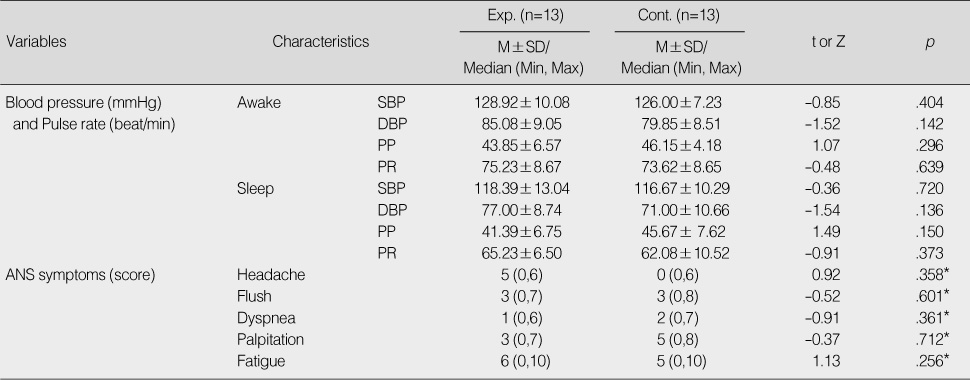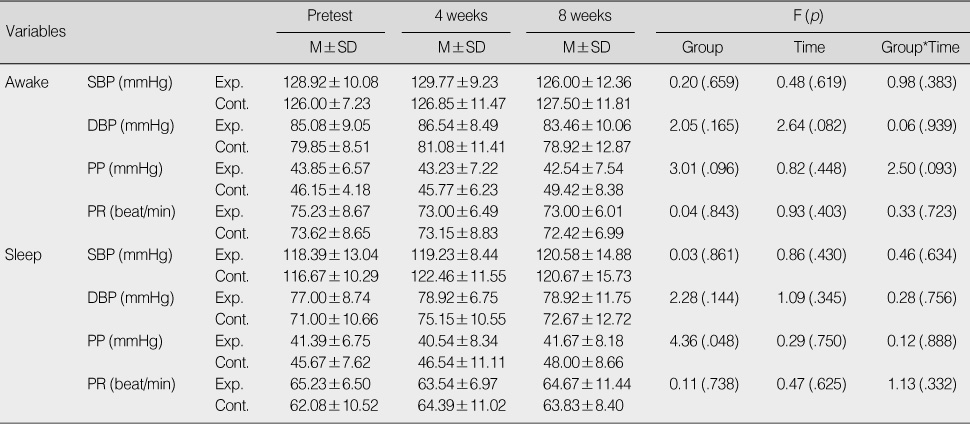Articles
- Page Path
- HOME > J Korean Acad Nurs > Volume 40(5); 2010 > Article
-
Original Article
- Effects of Moxibustion on Physiological Indices and Autonomic Nervous Symptoms in Adults with Prehypertension
- Soon Hee Cho
-
Journal of Korean Academy of Nursing 2010;40(5):686-694.
DOI: https://doi.org/10.4040/jkan.2010.40.5.686
Published online: October 31, 2010
Instructor, Department of Nursing, Inha University, Incheon, Korea.
- Address reprint requests to: Cho, Soon Hee. Department of Nursing, Inha University, 253 Yonghyun-dong, Nam-gu, Incheon 441-748, Korea. Tel: 82-32-860-8200, Fax: 82-32-874-5880, mariashcho@hanmail.net
Copyright © 2010 Korean Society of Nursing Science
Abstract
-
Purpose
- This study was done to examine the effects of moxibustion on physiological indices, such as 24-hr blood pressure, pulse pressure, and pulse rate, and autonomic nervous symptoms among adults with prehypertension.
-
Methods
- Participants were adults whose systolic and diastolic blood pressures were in the prehypertension stage and were not under treatment for the condition. Both experimental and control group consisted of 13 participants who were taking classes on acupuncture and moxibustion at a private institute. The experimental group received moxibustion once a day for 15 min, at least 5 days a week for 8 weeks. The results were analyzed using χ2-test, t-test, Fisher's exact test, Wilcoxon rank sum test and repeated measures ANOVA with the SAS program. Bonferroni correction method was adopted for multiple comparisons.
-
Results
- No significant change was observed in the 24-hr systolic and diastolic blood pressure between the two groups. Differences in the 24-hr pulse pressure and pulse rate were also not significant. However, significant decreases in headache, symptoms of flushing and fatigue were observed in the experimental group.
-
Conclusion
- The results suggest that moxibustion contributes to alleviating symptoms such as headache, flushing and fatigue associated with the autonomic nervous system among adults with prehypertension.
- 1. Avolio A. Pulse pressure and inflammatory markers. Journal of Hypertension. 2004;22:247–249.ArticlePubMed
- 2. Bang YH. The effect of moxa therapy on chronic constipation patients. 2005;Pocheon, Cha University. Unpublished master's thesis.
- 3. Braunwald E. Harrison TR, Kasper DL, Braunwald E, Fauci AS, Hauser SL. Disorders of the heart. In: Harrison's principles of internal medicine. 2003;15th ed. New York, NY, McGraw Hill. 1253–1377.
- 4. Chavanu K, Merkel J, Quan AM. Role of ambulatory blood pressure monitoring in the management of hypertension. American Journal of Health-System Pharmacy. 2008;65:209–218.ArticlePubMed
- 5. Cho BH, Kim GG, Kim CY, Lee ALN, Chung JC. The present and task of alternative medicine, acupuncture, and moxa. 2003;Seoul, Graduate School of Public Health, Seoul National University.
- 6. Chobanian AV, Bakris GL, Black HR, Cushman WC, Green LA, Izzo JR, et al. The seventh report of the joint national committee on prevention, detection, evaluation, and treatment of high blood pressure: The JNC 7 report. The Journal of the American Medical Association. 2003;289:2560–2572.PubMed
- 7. Chung NS. Medical management of hypertension. Korean Journal of Medicine. 2002;63:105–111.
- 8. Cohen J. Statistical power analysis for the behavioral sciences. 1988;2nd ed. Hillsdale, Lawrence Erlbaum Associates, Inc.
- 9. Domanski M, Norman J, Wolz M, Michell G, Preffer M. Cardiovascular risk assessment using pulse pressure in the first national health and nutrition examination survey (NHANES I). Hypertension. 2001;38:793–797.ArticlePubMed
- 10. Eguchi K, Kuruvilla S, Ogedegbe G, Gerin W, Schwartz JE, Pickering TG. What is the optimal interval between successive home blood pressure readings using an automated oscillometric device? Journal of Hypertension. 2009;27:1172–1177.ArticlePubMedPMC
- 11. Jee MS. The miracle of acupuncture and moxa therapy. 1995;Pyeongyang, Medical Science Publication.
- 12. Kang HS, Kim WO, Kim JW, Wang MJ, Cho JH. Effect of east-west self-help group program for rehabilitation of post stroke clients. Journal of Korean Academy of Nursing. 2004;34:1351–1361.ArticlePubMedPDF
- 13. Kim JH, Kim O. Influencing factors that affect the psychological well-being in family caregivers of stroke patients. Journal of Korean Academy of Nursing. 2005;35:399–406.ArticlePubMedPDF
- 14. Kim LW, Zhu J. Acupuncture for essential hypertension. Alternative Therapies in Health and Medicine. 2010;16:18–29.
- 15. Kim NC. The research on the effect of hypogastric breathing on the decreasing of blood pressure in essential hypertension patients. 2005;Seoul, Ewha Womans University. Unpublished doctoral dissertation.
- 16. Kim NS. Theory and practice of moxibustion. 1998;Seoul, Seowondang.
- 17. Kim NS. The effect of chu-ma therapy on the decreasing of blood pressure and stress in essential hypertension. Kwandong Medical Journal. 2000;4:137–146.
- 18. Kim SM. Property of drugs in hypertension. Journal of the Korean Academy of Family Medicine. 1998;19:234–246.
- 19. Kwon NH. The effect of moxa therapy on the decreasing of blood pressure in esssential hypertension. 2004;Gangneung, Kwan-dong University. Unpublished master's thesis.
- 20. Lee BH, Kim CH, Seo JC, Yoon HM, Jang GJ, Song CH, et al. The effect of acupuncture and moxibustion on the decreasing of blood pressure in hypertensive patients. Journal of Korean Acupuncture & Moxibustion Society. 2001;18:70–76.
- 21. Mourad JJ, Blacher J, Blin P, Warzocha U. Conventional antihypertensive drug therapy does not prevent the increase of pulse pressure with age. Hypertension. 2001;38:958–961.ArticlePubMed
- 22. Papademetriou V. Comparative prognostic value of systolic, diastolic, and pulse pressure. American Journal of Cardiology. 2003;91:433–435.ArticlePubMed
- 23. Park HS, Cho GY. Effects of foot reflexology on essential hypertension patients. Journal of Korean Academy of Nursing. 2004;34:739–750.ArticlePubMedPDF
- 24. Park JK, Kim CB, Choi SY, Kim DR, Chun SI, Lee SD, et al. Challenge of complementary and alternative medicine - worldwide currents and health policy implications. Korean Journal of Health Policy and Administration. 2000;10:1–30.
- 25. Schlebusch KP, Maric-Oehler W, Popp FA. Biophotonics in the infrared spectral range reveal acupuncture meridian structure of the body. Journal of Alternative and Complementary Medicine. 2005;11:171–173.ArticlePubMed
- 26. Shin KL. The development of Korean nursing alternative. Journal of Korean Academy of Nursing. 1999;29:1403–1418.ArticlePDF
- 27. Strandberg TE, Pitkala K. What is the most important component of blood pressure: Systolic, diastolic or pulse pressure? Current Opinion in Nephrology and Hypertension. 2003;12:293–297.ArticlePubMed
- 28. 2004 Korean hypertension treatment guidelines. The Korean Society of Hypertension. 2004;Retrieved February 2, 2005. from http://www.kaim.or.kr/main/files/02_01.pdf.
- 29. Uchida S, Suzuki A, Kagitani F, Nakajima K, Aikawa Y. Effect of moxibustion stimulation of various skin areas on cortical cerebral blood flow in anesthetized rats. American Journal of Chinese Medicine. 2003;31:611–621.ArticlePubMed
- 30. Van Bortel LMAB, Struijker-Boudier HAJ, Safar ME. Pulse pressure, arterial stiffness, and drug treatment of hypertension. Hypertension. 2001;38:914–921.ArticlePubMed
REFERENCES
Figure & Data
REFERENCES
Citations

- Liquid Chromatography‐Mass Spectrometry‐Based Plasma Metabolomics Study of the Effects of Moxibustion with Seed‐Sized Moxa Cone on Hyperlipidemia
Qinghua Shao, Jie Cheng, Yi Li, Guangxia Ni, Ian Cock
Evidence-Based Complementary and Alternative Medicine.2020;[Epub] CrossRef - Effect of moxibustion stimulation on repair of injured gastric mucosa after common peroneal nerve transection
Guo Chen, Juan Xiang, Li-zhi Ouyang, Fei Li, Li-ting Xiang, Ying Chen, Zhou Yang, Tie-lang Li, Liang Peng
Journal of Acupuncture and Tuina Science.2017; 15(3): 165. CrossRef - Effects of a Qi Massage Program on the Physio-psychological State of Industrial Employees with Hypertension
Yoon Ju Han, Kyung Sook Kang
Journal of East-West Nursing Research.2014; 20(2): 73. CrossRef - Moxibustion for essential hypertension
Xingjiang Xiong, Wei Liu, Xiaochen Yang, Bo Feng, Jie Wang
Complementary Therapies in Medicine.2014; 22(1): 187. CrossRef - Recovery effect of moxibustion at Nei Guan (PC-6) in xylazine induced bradycardia in dogs
Seong-Min Park, Hyung-Jin Park, Kyoung-Won Seo, Kun-Ho Song
Korean Journal of Veterinary Research.2013; 53(2): 89. CrossRef - The Effects of Hand Moxibustion and Hand Press Pellet on Blood Pressure, Blood Lipids and Blood Cell Components in Aged Women with Essential Hypertension
Yoo-Sun Shin, Eun-Ha Kim
Journal of Korean Academy of Community Health Nursing.2011; 22(2): 100. CrossRef - RECENT LITERATURE
Focus on Alternative and Complementary Therapies.2011; 16(2): 176. CrossRef
Homogeneity Test for General Characteristics of Participants
Exp.=experimental group; Cont.=control group.
*Fisher's exact test.
Homogeneity Test of Research Variables
Exp.=experimental group; Cont.=control group; SBP=systolic blood pressure; DBP=diastolic blood pressure; PP=pulse pressure; PR=pulse rate; ANS=autonomic nervous system.
Sleep=11 PM-6 AM; Awake=6 AM-11 PM.
*Wilcoxon rank sum test.
Effects of Moxibustion on Blood Pressure and Pulse Rate
Exp.=experimental group; Cont.=control group; SBP=systolic blood pressure; DBP=diastolic blood pressure; PP=pulse pressure; PR=pulse rate.
Effects of Moxibustion on Autonomic Nervous Symptoms
Exp.=experimental group; Cont.=control group.
abcdeSame letters indicate a significant difference between the two points in time.
Exp.=experimental group; Cont.=control group. *Fisher's exact test.
Exp.=experimental group; Cont.=control group; SBP=systolic blood pressure; DBP=diastolic blood pressure; PP=pulse pressure; PR=pulse rate; ANS=autonomic nervous system. Sleep=11 PM-6 AM; Awake=6 AM-11 PM. *Wilcoxon rank sum test.
Exp.=experimental group; Cont.=control group; SBP=systolic blood pressure; DBP=diastolic blood pressure; PP=pulse pressure; PR=pulse rate.
Exp.=experimental group; Cont.=control group. abcdeSame letters indicate a significant difference between the two points in time.
 KSNS
KSNS
 E-SUBMISSION
E-SUBMISSION




 Cite
Cite

